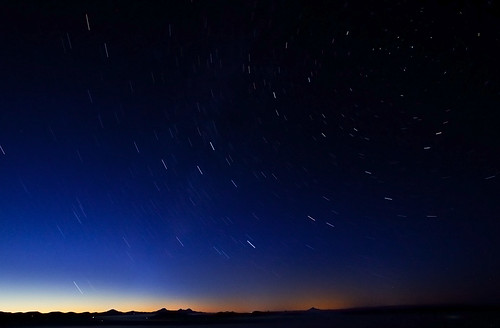Knowledge and Travel: Pine Mountain Observatory, Messier Objects
February 16, 2010
It had been my hope to merge my current site theme (The Heavens) with a winter weekend in Sunriver, Oregon. The high desert resort community usually has cold, clear weather at this time of year, and is far away from significant light pollution. That is, the stars can be heavenly, and I have in the past dabbled with entry-level astrophotography there with somewhat acceptable results.
I wanted to write for you about taking photos of stars. Alas, lingering between me and said celestial objects was a stubborn and weepy slab of clouds and mist that did not lift for the entire four days I was out there. Just to prove I have noodled with astrophotography in Central Oregon, here is a photo of David with a telescope:

This is a photograph I took of David, with a telescope. The white dots are stars, as might be expected.
Plan B: Foiled Again
My next heavenly plan was to go to the Pine Mountain Observatory. This little cluster of telescopes and scientists is perched at the top of the mountain I got married on. We piled our friends in our car on Saturday and drove the Subaru out east on the National Forest road that goes past the various caves on the northeast flank of Newberry Crater. This is a strange landscape of buttes and lava and volcanic echoes. You should go there sometime.

We stopped by Arnold Ice Cave for a bit. See if you can find David in this picture for scale.
We came up Pine Mountain on its gentler south slope, but it was no use. It was still the dead of winter. The red-cinder roads of the Millican Valley floor are, aside from some whopper early-season potholes, good and graded routes. Once you get onto the secondary roads that climb the ridges and draws, though, you’re in 4×4 territory, with gullies and axle-slicing boulders. While we do not shy away from adventure (David is a highly talented all-conditions and off-road driver), the weight of five grown folks reduced our already car-class ground clearance even further. Backseat passengers cringed as larger rocks scraped underneath.
For a few hundred yards, four of us got out and walked alongside the car, like pioneers walking next to a covered wagon, occasionally chucking large, loose rocks from the middle of the track. But when we hit a few inches of snow, we parked and started walking.
Surely the observatory was only a mile or so on; so indicated the icon on our map.
After an hour’s slog, trying to walk in each other’s tracks to lessen the grief of hiking in snow, we finally took a gasping break and said to hell with it. If you’ve never hiked in jeans in foot-deep snow up a monotonous mountain road, don’t.

Mike stares bleakly out at how far we'd have to go after stomping through snow for an hour.
This is the second time David and I have had a Pine Mountain Observatory fail. Last year or the year before we tried the northern approach, with even less success.
Pine Mountain Observatory
This is not to say we’ve never been to Pine Mountain Observatory. We have. One winter we were in a Jeep—high clearance, see—and made it all the way there. The astronomer didn’t get a lot of visitors at that time of year and so spent an hour or so explaining the current projects and equipment to us. It was neat.
PMO doesn’t have particularly impressive hardware. The largest telescope is 32 inches and their CCD has less resolution than even the cheapest camera phones (albeit it is “research grade” and quite sensitive). The observatory’s main focuses are community outreach and involvement, and staring at Messier objects.
Messier Objects
Messier objects are a ragtag group of not-comets, not-planets, not-stars that Charles Messier, a French astronomer, compiled in the late 18th century. These motley items might best be described as “blobs”, smears of something that in many cases can be seen perfectly well with the naked eye on a clear night. If you’ve ever seen astronomical objects referenced as “M” followed by a number, you’re probably looking at Messier nomenclature.
There are currently about 110 cataloged Messier objects, and astronomy clubs sometimes have a clever event called “Messier marathons” during which members try to see how many of the 110 they can spot during a single night. For some reason, that sounds like fun to me.
I have in my own life inadvertently photographed a Messier object:

The clump of spots/stars in the middle left of this photograph, taken on Mt. Hood last winter, is the Andromeda galaxy, also known as Messier Object 31 (M31)
Other examples of Messier objects include the Orion Nebula (M42), the Pleiades (aka M45, aka Subaru), and the Milky Way stripe (M24).
A Delightfully Corny Video by the Oregon Department of Transportation about the Pine Mountain Observatory
Some Other Photos I have Taken of Stars

This photograph was taken “piggybacked” onto David’s telescope with a motor drive. That keeps the telescope (and in this case, the camera) in synch with the rotating earth such that one does not get appreciable star trails. This photo was taken in the same place as the one above.
Sources
Recently Reviewed
Get the Books
Read my Reviews
Related Posts
- Site Theme: The Heavens
February 8, 2010 - Photo: The Moon, by David!
November 24, 2010 - Jupiter Week: Thursday: Io, the little pustule of the sky
November 18, 2010 - Oregon: Most Scenic Places
February 17, 2010 - Knowledge: Earthshine and the moon’s full earth
February 24, 2010




